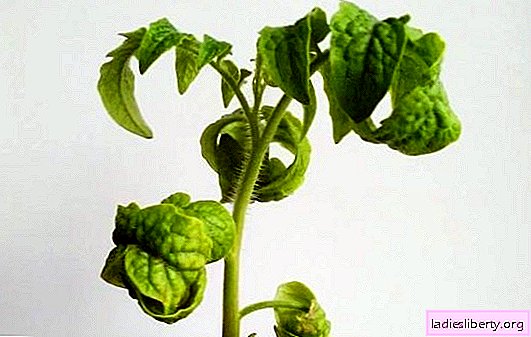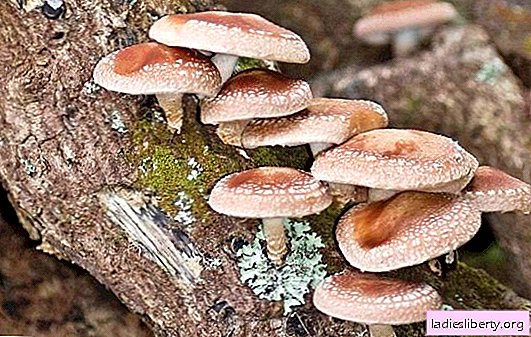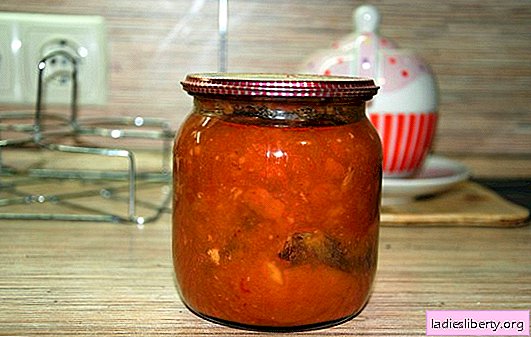
When you sow tomatoes for seedlings, you take responsibility for the future crop.
If there are any mistakes in the care of tomato seedlings, then they often signal this by twisting the leaves.
Unfortunately, not every gardener can determine the causes of such plant behavior. Twisting the leaves in seedlings can lead to low yields, poor-quality fruits and even cause the death of bushes. Knowing what the symptom says, you can quickly diagnose trouble and immediately help the plant.
Tomato seedlings twist leaves - reasons
Usually problems begin some time after a dive of tomato seedlings.
Experienced gardeners are responsible for caring for tomato seedlings, for this reason even a minimal deviation in their development causes them to naturally worry. But the anxiety is not always justified - if the seedlings twist the leaf blades, acquiring the appearance of a chicken foot, you should not worry.
This is due to the fact that the vein on the leaf grows, outstripping the leaf plate in development, therefore, twisting occurs. Also, the tips of the leaves can curl, as this is a feature of some varieties of tomatoes, which is especially noticeable in young tomatoes.

Tomato seedlings twist leaves, the reasons for this may be:
1. Feature of the variety. Leaves of this kind can be found in tomato varieties - cherry and such varieties as - "Honey Drop", "Okshart", "Fatima";
2. Disease of bacterial cancer. You can find out that the plants were affected by this disease by the following symptoms:
• The lower leaves fade, change color and dry;
• Sores and cracks appear on the petioles and stem of the tomato;
• A brown ring is noticeable on the cross section of the stem.
3. The lack of mineral elements.
Not everyone knows how to properly feed tomato seedlings. You can find out what tomatoes are missing by these signs:
• Phosphorus - the veins on the leaves acquire a purple-red hue, and the plate itself becomes gray-green;
• Boron - young leaves begin to curl, adult leaves turn yellow, the veins on them turn purple;
• Sulfur - young leaves become curved, necrotic spots form on them;
• Copper - the ends of the leaves and their petioles are bent down, after a while chlorosis and necrosis appear on the plate.
4. Excess zinc and boron. An overdose of these elements can be noticed by such signs:
• Boron - the ends of the leaf blade bend down, dry and become brittle, the leaves begin to bend from the bottom and gradually the bend reaches the ends;
• Zinc - old leaves bend down, the bottom of the leaf blade turns purple.
5. During transplantation, the root system is injured. Seedlings of tomatoes with damaged roots first receive nutrients from internal tissues. But after a while from a lack of nutrition, the leaves of the plant begin to curl down.

Regime for sick tomato seedlings
Seedlings of tomatoes wilt sometimes due to sudden changes in temperature or irrational irrigation. Both insufficient and too plentiful watering are equally harmful to seedlings.
Pour or underfill
Strong or very frequent moistening of the soil under the tomatoes removes oxygen from it - vital gas for tomato roots. The root system in wet soil cannot breathe and begins to rot. Tomato bushes signal wilting green mass or curling leaves. All the time, wet soil additionally provokes the active reproduction of pathogens of fungal diseases. Inadequate, superficial or too rare watering leads to improper root development. Instead of delving into the soil, they begin to creep horizontally. Such a tomato bush grows weak, and when transplanted to a permanent place, it is very sick and can even die.
Tomatoes in the heat are saved by leaves
A sharp and prolonged increase in air temperature leads to curl of the leaves - this is the natural protection of the plant. The reason is that prolonged heat to preserve moisture causes the desire to minimize the surface that evaporates the precious moisture. And the plant has a maximum evaporating area - the leaf apparatus.
Folding and bending, the leaves retain moisture under the hot sun, and even out again in the evening, the seedlings take on a normal appearance.
Root resuscitation
Injuries to the roots during planting seedlings in a permanent place, lead to the need to rebuild the root system. Plant nutrition due to injured roots becomes insufficient. The term "treatment" can be reduced by timely top dressing.
Excessive zeal
Sometimes, tomato seedlings twist leaves, as a result of accidental damage to the bushes when removing stepsons. Impatient gardeners cut off all unnecessary shoots at once. For a young plant, this is a strong stressful blow that delays its development for a long time and can lead to the death of a seedling. Stepsons can be cut off for 1-2 pieces, with breaks for 1-2 days, you can not only let them grow longer than 6 cm.
Pest attack
Tomato seedlings twist leaves as a result of the multiplication of some pests. A constant inspection of plants will make it possible to notice the attack in time and immediately take the necessary measures.
Aphid, which is familiar to you from indoor plants, does not mind eating delicate leaves and juicy stalks of tomatoes. An undetected pest will quickly cover young sprouts and start sucking juices from them. For this reason, even if you find single pests, you must immediately begin to fight them. With early detection, this misfortune can be dealt with using grandfather's recipes - infusions of ashes, onions, garlic. If the aphid has time to breed, it will be necessary to apply chemical compounds that can be purchased in specialized stores.
Spider mite sometimes also harms tomato bushes. Insects inhabit the lower surface of the leaves, symptoms of infection:
• Small yellowish or white punctures on a leaf blade;
• A whitish web of whitish color under the leaves.
As a result of the vital activity of this insect, the leaves twist in tomatoes, gradually bending inward, after a while they dry out and fall off. Destroy the spider mite will help alcohol. They spray or wipe the diseased plants. The treatment is repeated after a week. Water infusions of garlic, horseradish, tobacco, dandelion can also help in the fight against this scourge (mainly to deter pests, as a preventive measure). With a strong infection of plants, it is necessary to treat the bushes with chemical compounds.
Bacteria, viruses, fungi
Withering of stems and twisting of leaves also occurs due to fungal, viral diseases and the propagation of pathogenic bacteria. The most common of them are alternariosis, necrosis, bacteriosis, tobacco mosaic virus.

Alternariosis. The leaves of the plant curl, become stained, and then dry out.
Necrosis of the stem. At the bottom of the stem, cracks become visible, aerial roots form from them, the plant weakens and withers, leaves fall off it. Sick bushes are destroyed (preferably burned).
Bacteriosis. The plant dries out within a few days for no apparent reason. On a dry bush you can detect the darkening of the stem and the appearance of empty spaces. To save the rest of the plants, suspicious seedlings must be destroyed.











